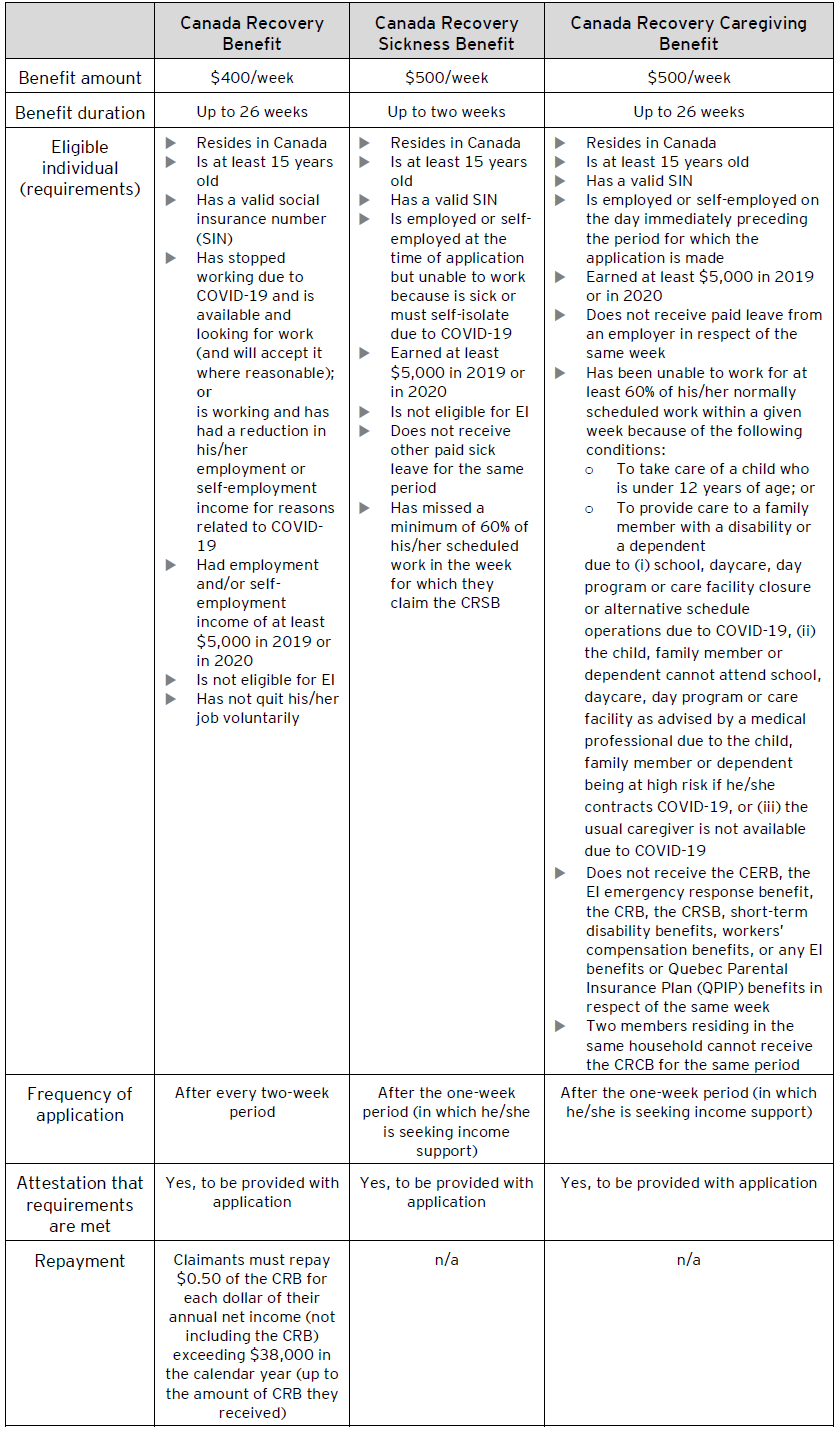
Transition plan from the CERB announced
Tax Alert No. 45, 25 August 2020
On 20 August 2020, the federal Minister of Employment, Workforce Development and Disability Inclusion, Carla Qualtrough, and the Deputy Prime Minister and Minister of Finance, Chrystia Freeland, announced the government’s $37 billion plan to transition from the Canada Emergency Response Benefit (CERB) into a simplified and enhanced Employment Insurance (EI) program or new benefits.
The plan includes four main components, which are further discussed below:
- A four-week extension of the CERB
- A temporary simplification and enhancement of the EI program
- The addition of three new temporary benefits
- A freeze of the EI premium rates for two years
Four-week extension of the CERB
The 24-week CERB program, which was scheduled to end on 29 August 2020, will be extended by four additional weeks to 26 September 2020, under the same eligibility criteria. Individuals that continue to meet the eligibility criteria will thus be able to reapply for one additional four-week period.
Given that subsection 8(2) of the Canada Emergency Response Benefit Act permits the Minister of Employment and Social Development to fix the maximum number of weeks for the CERB by regulation, no new legislation is required for the CERB extension — the prorogation of Parliament on 18 August 2020 should thus have no impact. We expect that the Income Support Payment (Number of Weeks) Regulations will be amended accordingly.
At the end of the CERB program, individuals eligible for EI who are already receiving benefits through Service Canada will be transitioned to the EI program. Individuals who are currently receiving the CERB from the Canada Revenue Agency (CRA) who believe they are entitled to EI will need to apply through Service Canada after 26 September 2020. Individuals not eligible for the simplified and enhanced EI program will be able to apply through the CRA to one of the three new temporary benefits (described below).
Temporary simplification and enhancement of the EI program
To simplify and enhance the EI program, the following temporary changes will be made:
- Minimum unemployment rate – Effective 9 August 2020 and as first announced on 10 August 2020, a unique minimum unemployment rate will be deemed to be 13.1% in all 62 EI economic regions in Canada for one year. As a result, EI claimants in EI economic regions with an actual unemployment rate lower than 13.1% will have their EI benefits calculated on the basis of the 13.1% rate (those in regions with a higher rate will continue to have their EI benefits calculated using the actual higher rate).
- One-time insurable hours credit – EI claimants will receive a one-time credit of 300 insurable hours for claims for regular EI benefits and of 480 insurable hours for claims for special EI benefits (i.e., sickness, maternity/parental, compassionate care or family caregiver benefits). This credit will be available for new EI claims for one year and, for special or work-sharing benefit claims, will be retroactive to 15 March 2020 (the qualifying period will accordingly be extended in this case).
- Minimum number of insured hours – The minimum number of insured hours required to qualify for the regular EI benefits will be lowered to 420 hours, or 120 hours (after applying the one-time credit of 300 hours), in all 62 EI economic regions (instead of generally ranging from 420 to 700 hours currently, depending on the actual economic rate of unemployment where the claimant is residing). Similarly, the minimum number of insured hours required to qualify for the special EI benefits will also be lowered to 120 hours (after applying the one-time credit of 480 hours), in all 62 EI economic regions (instead of the current 600 hours requirement).
- Minimum number of weeks of benefit entitlement – EI claimants will be entitled to a minimum of 26 weeks of regular EI benefits (instead of ranging from 14 to 26 currently, depending on the actual economic rate of unemployment where the claimant is residing and the number of insurable hours accumulated). Similarly, the number of best weeks of earnings used in the calculation of the weekly benefit rate will be set at 14 (instead of ranging from 14 to 22 currently, depending on the actual economic rate of unemployment where the claimant is residing).
- Minimum benefits – Effective 27 September 2020, new EI claimants will receive a minimum benefit rate of $400/week (or $240/week for extended parental benefits), if it is higher than what their benefits would otherwise be (instead of generally currently being based on the claimant’s average weekly earnings before their EI claim). Similarly, self-employed EI fish harvesters who rely on EI fishing benefits in the off-season will be allowed to temporarily calculate their EI fishing benefits using either their actual fishing earnings for their current claim or their fishing earnings from their claim for the same season from the previous year, whichever is higher.
Given that under subsection 153.3(1) of the Employment Insurance Act, the Minister of Employment and Social Development may make interim orders for the purpose of mitigating the economic effects of COVID-19, no new legislation needs to be introduced by the government to adopt the abovementioned changes — the prorogation of Parliament on 18 August 2020 should thus have no impact. In fact, some of these changes (e.g., in respect of the minimum unemployment rate) have already been made and enacted by SOR/2020-173, Interim Order No. 7 Amending the Employment Insurance Act (Employment Insurance Emergency Response Benefit). Additional interim orders are expected to be made.
New temporary benefits
Effective 27 September 2020, three new temporary benefits will also be available: the Canada Recovery Benefit (CRB), the Canada Recovery Sickness Benefit (CRSB) and the Canada Recovery Caregiving Benefit (CRCB).
These benefits, which are taxable and summarized below, will be available for one year and are essentially targeted at self-employed individuals and individuals not eligible for EI.

Individuals will be able to apply for these three new benefits through the CRA, as they will be administered by the CRA. Details on how and when Canadians can apply will be provided by the CRA in the coming weeks. However, the government needs to introduce and enact legislation to deliver these benefits, and this will not occur until after the 23 September 2020 Throne Speech (Parliament is currently prorogued until then) and provided the government, which is in a minority situation, survives the confidence vote on the Throne Speech.
Two-year freeze of the EI premium rates
The government will be freezing the EI premium rate for employees at the 2020 level of $1.58 per $100 of insurable earnings for two years. Similarly, the rate for employers will also remain unchanged at $2.21 per $100 of insurable earnings.
The EI premium rate for residents of Quebec covered under the QPIP will remain $1.20 per $100 of insurable earnings, while their employers will continue to pay $1.68 per $100 of insurable earnings.
Given that under subsection 66.32(1) of the Employment Insurance Act and on the joint recommendation of the Minister of Employment and Social Development and the Minister of Finance, the Governor in Council (instead of the Canada Employment Insurance Commission) may set the premium rate, no new legislation needs to be introduced by the government to adopt the freeze — the prorogation of Parliament on 18 August 2020 should thus have no impact.
Learn more
For more information, please contact your EY advisor.
Budget information: For up-to-date information on the federal, provincial and territorial budgets, visit ey.com/ca/Budget.

